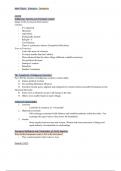Class notes
American History 1700-031 Class Notes
- Course
- History 1700-031
- Institution
- University Of Utah
Explore the rich tapestry of American history through comprehensive notes from the University of Utah's history class. Delve into the intricacies of key events, influential figures, and socio-political movements that have shaped the nation. Gain a nuanced understanding of the diverse components tha...
[Show more]



